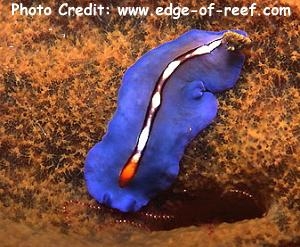
By Bob Goemans


There are about 15,000+ species in the Phylum Platyhelminthes, with about 10,000 of them being considered a parasitic type creature to fish and invertebrate, such as flukes, tapeworms and the tiny flatworms that occasionally infest corals in our aquariums.
Many flat worms can easily be mistaken for nudibranchs, as their color and body shape is quite similar. However, most are paper-thin oval shaped, can move quite rapidly, and do not have external gills. They 'glide' on a secreted coating of mucus and if disturbed, can swim away in with an undulating motion. These hermaphrodites have both male and female organs and can also regenerate from body fragments. They are carnivorous predators and generally feed upon colonial ascidians, making them almost impossible to maintain in closed systems. Occasionally they arrive on the bottom of live rock, and are infrequently seen after that.
Of major interest to aquarists is the flat worm called 'Planaria' and actually is not among what is considered 'parasitic' flat worms. The ones I've seen, Convolutriloba retrogemma 1, look like reddish-brown freckles with a forked tail and slightly rounded top. They are about the size of a freckle (.25 inch - 2 - 5 mm) and can rapidly increase in number to the point where they may cover an entire coral specimen. Mushroom and leather corals seem to be a favorite gathering place. They are thought to be harmless (Sprung, 2000) yet unsightly, however, they will suck out body fluids containing zooxanthellae. When in great numbers they can also block light from reaching photosynthetic animals. Click on the following to see examples of these pests - Notoplana tremellaris, now called Leptoplana tremellaris.
When there is an abundance of them and if possible, remove the infected specimen and give it a five to ten second freshwater dip. Almost all the flatworms will drop off and any remaining can be gently brushed off. Caution, not all corals can withstand a freshwater dip.
Since these worms are photosynthetic, they are attracted to light. Placing a lamp near the aquarium at night will attract them in huge numbers making it easy to siphon out the majority of them very early the next morning. The reduced number may give other biological control methods a better chance at bringing their numbers under control.
As for biological controls, the Banded Goby, Amblygobius phalaena, is said to eat this flatworm. Also, Wrasses, e.g., the Sixline Wrasse Pseudocheilinus hexataenia, Leopard Wrasse (Macropharyngodon meleagris), and Yellow Wrasse Halichoeres chrysus. Also some Anthias are thought to be an efficient consumer of this pest, as are Peppermint Shrimp (Lysmata wurdemanni) and also those in the Lysmata genus. In fact, the Mandarin fish (Synchiropus splendidus) has cleared up the problem in some of my past reef systems. Also, the Sea Slug/Nudibranchs in the genus 'Chelidonura sp.' are believed to be a very good consumer, although very short-lived slugs. Also, scooter blennies and hawkfishes may also consume them.
Some aquarium shops keep at least one Chrysiptera springeri (Damselfish) in their tanks where they maintain coral specimens for sale, as it feeds on these pest flatworms. In fact, I’ve used one in an aquarium that had some flatworms, and soon after the introduction of this damselfish flatworm sightings ended! I’ve also found this species to get along with its various tankmates quite nicely.
There is also some thought these flat worms can rapidly go away due to some biological clock, lack of foodstuffs or a biological competitor. Also, there's some thought the over use of iodine supplements, which flat worms may concentrate in their internal fluids, may lend itself to promoting their proliferation.
There is some thought that killing these flat worms, such as Convolutriloba retrogemma in large numbers could present a toxic condition in the closed system by stripping its oxygen in the degradation of large numbers of these pest flat worms and in the release of iodine in some format, as they harbor iodine in their tissues. Increased water flow and improved protein skimming is also helpful. Recently, (2003) a product from Salifert called Flatworm Exit has been said by some aquarists to safely reduce the population of these pests without harm to other invertebrate. Caution is advised.
Because it would serve no useful purpose to proved detailed information about these creatures, I've decided to simply provide photos of several of these creatures so as to help identify them should they show up in your aquarium.